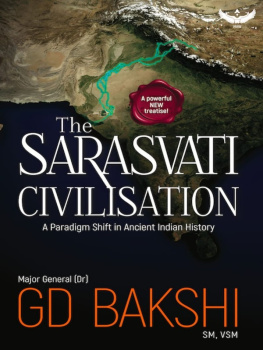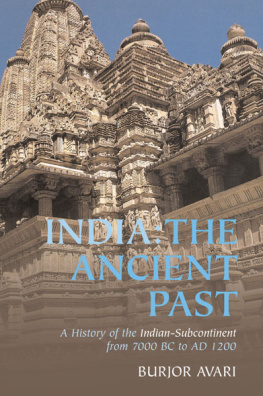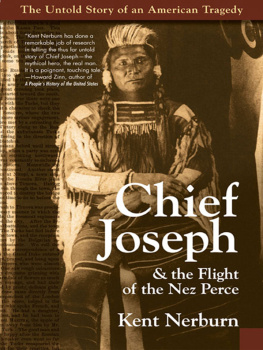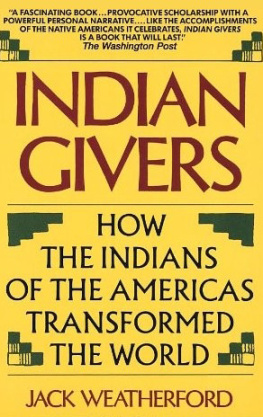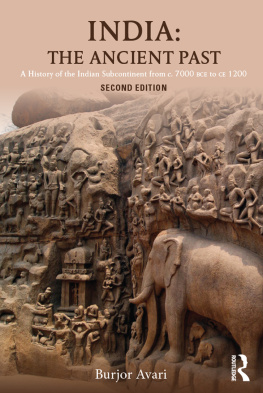This section is unusually long because there are so many academics, scientists and experts from fields as diverse as archaeology, genetics, linguistics, epigraphy, philology and history that I need to thank for sharing their knowledge with me over the last six years. In the course of those years, I got to know some of them personally and all of them professionally, through their academic work of decades. If there is anyone whose name should be here but is not, my apologies for the inadvertent omission.
I must begin my acknowledgements by remembering four stalwarts who are no longer with us. Indias best-known epigraphist, Dr Iravatham Mahadevan, passed away as this book was going to press. The time I spent with him at his home in Chennai, when we discussed the toughest problem in Indian prehistory that he had been grappling with Harappan script decipherment will remain a treasured memory. His leaving at precisely the time when his insights into the nature of Indian civilization are being proved right by latest discoveries is particularly heartbreaking.
Equally unfortunate has been the loss of the eminent archaeologists Professor M.K. Dhavalikar and Professor V.N. Misra, who served, at different times, as directors of the premier institution for archaeology in South Asia, Deccan College, Pune, and the geneticist Professor Lalji Singh, who was the vice chancellor of Banaras Hindu University (BHU). Both Dhavalikar and Misra welcomed me into their homes in Pune, and shared with me their deep understanding of the Harappan Civilization in a way that reading any number of papers would not have matched. Singh, whom I met at BHU, gave me a glimpse of the potential of genetic science in India.
The doyens of history and archaeology in India Professor Romila Thapar, who has authored many books that have become the standard bearers for ancient Indian history, and Dr B.B. Lal, former director general of the Archaeological Survey of India (ASI) were also generous with their time when I met them in Delhi. Thapar pointed me in the right direction early on in my research and with her incisive comments prompted me to rethink my arguments. Lal helped sharpen my understanding of the Aryan migration debate.
The globally renowned philologists and Sanskritists Professor Michael Witzel of Harvard University and Professor Sheldon Pollock of Columbia University were of immense help in the writing of this book. Pollocks groundbreaking works on Sanskrit and my email conversations with him threw new light on our history in the early centuries of the Common Era. Witzels seminal work on the oldest texts of India, his treatises on critical issues of Indian prehistory and my calls and email exchanges with him provided me with sharp new perspectives. I thank both of them for reading my manuscript and making invaluable suggestions and comments.
As readers would have noticed, much of the ancient DNA research that is rewriting global prehistory is led by Professor David Reich of the Harvard Medical School. His book, his research papers and my interactions with him were crucial points in my journey into our prehistory.
Dr Kumarasamy Thangaraj of the Centre for Cellular and Molecular Biology (CCMB), Hyderabad, was often a co-author or co-director of some of these reports and I had the opportunity to meet him at CCMB during the early stages of my work. Thangaraj has authored many impactful research papers on Indian population genetics.
Four people deserve special mention for the role they played in shaping this book, directly or indirectly: Professor Ravi Korisettar of Karnatak University, who has done some of the most remarkable work in Indian prehistory; Partho Majumder, geneticist and distinguished professor at the Indian Statistical Institute, Kolkata; Professor Vasant Shinde, director of Deccan College; and Professor Shereen Ratnagar, author of many well-known books on Harappan history.
Ratnagar was always willing to engage and was forthright in her criticisms. Shinde gave me access to the impressive library at Deccan College, Pune. Majumders work on Indian genetic history was an eye-opener when I began research on this topic. Korisettar made possible my visit to Jwalapuram in Andhra Pradeshs Kurnool district and Sanganakkallu in Karnatakas Bellary district, sites that he excavated. Korisettar is now building a museum dedicated to prehistory in Bellary.
As fascinating to me as these sites in Karnataka and Andhra Pradesh was the lab-cum-office of Shanti Pappu, archaeologist and professor, on the outskirts of Chennai. The decades-long work of Pappu and her team at Attirampakkam has been a remarkably productive one.
Two other archaeologists whom I met were Professor Emeritus K. Paddayya of the Deccan College, who excavated the HunsgiBaichbal valley of Karnataka, among other sites; and Dr R.S. Bisht, who excavated the most important Harappan site in India, Dholavira.
The turning point in the making of this book came in June 2017, with my writing of an article for The Hindu, titled How Genetics Is Settling the Aryan Migration Debate. There are two people who made that article possible Professor Martin B. Richards of the University of Huddersfield, UK, a global authority on mtDNA, and Dr Peter Underhill of Stanford University, a global authority on the Y-chromosome. Richardss paper on the genetic chronology for the Indian subcontinent revealed to me past research findings in a new light. Underhill has been at the forefront of many path-breaking discoveries in population genetics. I am thankful to both of them for their generous help.
Vagheesh Narasimhan of Harvard Medical School and lead author of The Genomic Formation of South and Central Asia was of tremendous help to me in understanding the nuances of recent research, and the interconnections between them. Priya Moorjani, now with the University of California, and a lead author of a study on the dating of genetic admixture in India, was another source of insight.
I met the geneticist Dr Niraj Rai, a co-author of the paper on the genomic formation of South and Central Asia, at the Birbal Sahni Institute of Palaeosciences in Lucknow, where he is building a lab that will have the capability to analyse ancient DNA. Rai is today the person most closely working with ancient DNA research in India.
The linguists who were most critical to the writing of this book were Professor Franklin C. Southworth and Dr David W. McAlpin, both of them experts on South Asian languages. I could not have written the chapter on the Harappans without their cooperation. McAlpin, who authored the most comprehensive paper on the link between Dravidian languages and Elamite, spared hours of his time to discuss with me the intricacies of Dravidian and Elamite linguistics and the impact of recent genetic discoveries.
The well-known archaeologist Professor Michael Petraglia was another scientist who was of much and timely help. My conversation with him enabled me to get an understanding of the Out of Africa migrations through Arabia.
Historian and professor, R. Champakalakshmi, whom I met in Chennai, graciously helped me gain a better understanding of South Indian history. Astrophysicist and author of the insightful book The Vedic People, Dr Rajesh Kochhar and the geneticist Dr Gyaneshwer Chaubey are among the many others whom I got to interact with in the course of writing this book.
It is important to note here that not all whom I have met have been of the same opinion many have been at the opposite ends of key debates in Indian prehistory. Which is why it was essential for me to meet or talk with all of them and hear their arguments.
Equally important is this caveat: I place no burden of responsibility for any errors that may have crept into my book on the people whom I met, talked with or relied on in the writing of it. All responsibility for errors, if any, rests solely with me.
Next page





